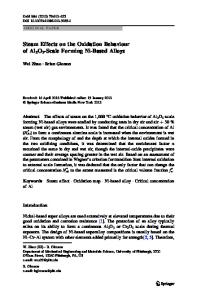Effect of Strain Rate on the Plastic Behaviour of Ll 2 Compounds Based on Ni 3 Al
- PDF / 322,268 Bytes
- 6 Pages / 420.48 x 639 pts Page_size
- 77 Downloads / 330 Views
EFFECT OF STRAIN RATE ON THE PLASTIC BEHAVIOUR OF Li 2 COMPOUNDS BASED ON Ni 3 Al SEIJI MIURA, SHOUICHI OCHIAI , YOSHIHIRO OYA YOSHINAO MISHIMA AND TOMOO SUZUKI Research Laboratory of Precision Machinery and Electronics, Tokyo Institute of Technology, Nagatsuta, Midori-ku, Yokohama 227, Japan (Y.Oya is now with Meisei University, Hodokubo, Hino-shi, Tokyo 191, Japan), Nagaoka Technological University, Kamitomioka-cho, Nagaoka, Niigata 940-21, Japan ABSTRACT In both single and polycrystalline Ni 3Al, no strain rate dependence of 0.2% flow stress is observed in a temperature range where anomalous positive temperature dependence of strength is exhibited. A distinct strain rate dependence is observed, however, in single crystals when the test temperature is raised beyond the peak in flow stress. It is shown that (111) type slip involving diffusional process is responsible for the strain rate sensitivity at near [001] orientation, while (001) type slip which is governed by the Peierls mechanism at orientations away from [001]. In polycrystalline compound with a fine grain size an apparent loss of the positive temperature dependence of strength is observed at a slower strain rate due to grain boundary sliding. INTRODUCTION Investigation on plastic behaviour of the L12 type compounds based on Ni 3 Al have been actively motivated because of their anomalous positive temperature dependence of strength. Tension/compression asymmetry as a function of orientation of stress axis in single crystals has been one of the major interests to clarify the effect of relative magnitude of critical resolved shear stress (CRSS) for (111) and (001) slip systems[l-3J.. This is because the magnitude of the mechanical anomaly is governed by the occurence of thermally activated cross slip of screw segment on glide (111) planes to non-glide (001) planes. Most of the previous works, therefore, have centered on the plastic behaviour at temperatures up to the peak in flow stress(Tp at a constant strain rate except for a few cases[4-6]. Our primary interest here is to clarify the effect of strain rate on the plastic behaviour of Ni 3 A1 not only in single crystalline but also in polycrystalline over whole temperature range, especially above Tp. It is a summary of our recent series of works[7-9J. EXPERIMENTAL Single crystalline Ni3 (Al,5at%Ti) was grown by Bridgeman technique and polycrystalline Ni 3 Al(24at%Al) with 0.05 mass% B was prepared by recrystallization upon annealing of cold rolled alloys to have various grain sizes ranging from 4 to 275 11m. Compression tests were carried out using specimens with a dimension of 3 x 3 x 6 mm3 at temperatures ranging from 77 K to 1273 K and at several strain rates. RESULTS AND DISCUSSION Plastic behaviour of single crystalline Ni 3 (Al,Ti)
Mat. Res. Soc. Symp. Proc. Vol. 133. ©1989 Materials Research Society
342
1200 1.4x 10 s "
1.4x 10-3
1.4x 106
1.4x 10-2
1173K 1000
-1073K
800 IL
f
1223
107310
1023K
3
07
.1123
873 1073
1173K
12
773
7733
400
c 001
O11
20
Strain
Fig. 1 Compressive
Data Loading...











